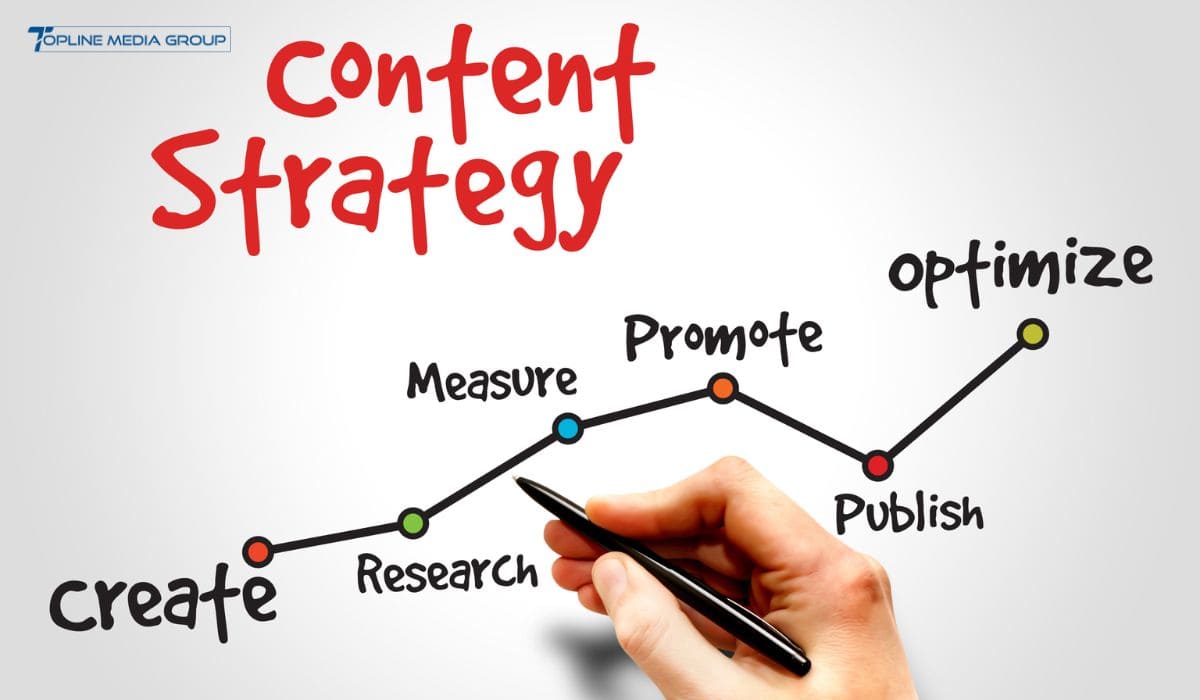Content marketing is at the core of modern business practices, ensuring brands keep in touch with their audiences, gain authority in their niche, and propel business growth.
While most companies are into content marketing, not many measure the return on investment (ROI) they derive from their content marketing activities.
The best ROI in content marketing is more than writing a blog post and updating your social media pages.
Earning the best ROI for content marketing aligns your content marketing strategy with the business goals, using every piece of Content to a specific objective.
For the article, we will research ways to develop a content marketing strategy that maximizes ROI, mainly through alignment with business objectives, tracking the right metrics, and optimizing efforts.
What is a Content Marketing Strategy?
A content marketing strategy is a structured outline that explains how a business can use Content to successfully achieve marketing and business goals.
Such a strategy includes:
- Details of the target audiences and the types of Content to be created, such as a blog post, video, or infographic.
- The distribution channels where it has to be placed.
- Defining measurable goals.
The significant aim of a content marketing strategy is to attract, engage, and convert your target audience in a way that drives business measures, be it sales, brand awareness, or lead generation.
For a content marketing strategy to be successful, it needs to align with your broader business goals.
Otherwise, creating Content that would attract your target audience is easy, but it still fails to push forward your company’s growth and success.
Why Align Content Marketing with Business Goals?
The most common pains of businesses with content marketing include the failure to connect their content efforts with business objectives, wasted resources, ineffective campaigns, and difficulty in ROI demonstration.
You ensure every piece of Content produced within your strategy will serve the purpose of brand awareness, generating leads, or driving conversions.
Key Aligning Reasons:
More Effectiveness:
Whenever your Content aligns with business goals, there will be less waste of time and more effective resources with every effort.
More Measurable Results:
If the Content aligns directly with a business objective, the return on investment can be easily determined through measures.
Better Decision Making:
Such strategic decisions make it easy to ensure that all marketing decisions contribute to your long-term business strategy by aligning the Content to business goals.
How to Design a Content Marketing Strategy that Supports Business Objectives

Define Business Objectives
Creating Content cannot be done without knowing what your business is trying to do.
Here’s where you get started by defining your business objectives.
Do you want to increase brand awareness?
Generate leads?
Improve customer retention?
This should do the SMART trick.
Goals. Clear business goals will ensure your content marketing efforts dovetail with your organization’s bigger plan.
For example, your business goal is to boost revenue by 20% within a year.
In that case, it means that the focus of your content marketing has to be on creating leads-generating, prospect-converting into customers, and supporting sales.
Know Your Target Audience
The alignment of Content with business goals mainly depends on your target audience.
Who do you want to reach?
Then, personalize your Content in greater detail for every target audience segment by creating a rich buyer persona that expands on needs, challenges, and interests.
Create buyer personas to create relevant content that profoundly resonates with the target audience and provokes engagement.
Think about the demographics, preferences, and behaviour of your target audience.
For instance, if you’re a B2B, it will be much more data-driven and educational, while B2C content will be more emotional and engaging.
Create a Content Strategy
From there, knowing your business purpose and objective allows you to develop a content plan.
The details will include the types of Content you intend to create, topics to cover, and communication channels to reach your audience.
Types of Content:
There should be a content format mix, including blogs, videos, infographics, podcasts, case studies, and eBooks.
Different types of Content serve various purposes and appeal to varying times in the buyer’s journey.
Topics:
The topics are relevant to the needs of your audience, as well as toward achieving your business goals, such as lead generation topics, producing Content around a pain point solution and positioning your product or service as the best option.
Distribution Channels:
Select the best mode of distribution channels for your Content.
According to your target audience, you might use email marketing, social media marketing, SEO, paid ads, or influencer marketing to boost the views on your Content.
Optimization of SEO and User Experience
Since SEO is how Content you post online will attract organic traffic, optimizing the Content with valuable keywords- which may even include your targeted keyword phrase “content marketing strategy”-could help boost the rankings for your Content, thus improving its ease of finding by a potential customer.
Suppose the content is readable and engaging and permits easy navigation using mobile devices.
In that case, the user experience will improve, and the chance to keep visitors at the site longer will increase.
Focus on the following:
- On-page SEO: Target your keyword in titles, headers, meta descriptions, and bodies.
- Technical SEO: Speed up your website, make sure it is mobile responsive, and structure a friendly site to help boost rank in search engines.
- Content Quality: Mix long Content with short Content. The quality of value pieces should be of the utmost priority.
Track the Right Metrics
Measuring content marketing success would show you if your investment would result in your desired return.
This can best be achieved by tracking KPIs more relevant to your business objectives.
Common KPIs include:
Traffic Metrics:
Track page views, unique visitors, and bounce rates to assess how well the Content attracts and engages visitors.
Engagement Metrics:
Measure the time spent on a page, social shares, comments, and interactions to find out whether your Content is engaging enough or not.
Conversion Metrics:
Measure lead generation, click-through rates (CTRs), sales conversions, etc., and assess how reasonable your Content is in converting leads.
Revenue Metrics:
Measure the Return on Investment from content marketing by comparing the revenue generated from content-driven leads versus the money spent on producing and promoting Content.
Continuously Evolve Your Strategy
It definitely is not a “set it and forget it” effort:
With periodic tweaks, content marketing is optimized in terms of effectiveness and attains a good return on investment.
Monitor your Content’s performance regularly using the above metrics and adjust based on what works and doesn’t.
For example, invest more resources if a particular content or distribution channel outperforms others.
On the other hand, if you find some underperforming content, try to repurpose it, experiment with new formats, or optimize the Content for better SEO.
Common Mistakes in Measuring ROI of Content Marketing
Where content marketing can be an ROI accumulator, most businesses face problems in measuring the effectiveness of ROI because of a few significant challenges:
- The attribution challenge;
- In other words, Content influences leads over time and across multiple touch points, so it is tricky to attribute a conversion to a specific piece of Content.
- Focusing too much on short-term metrics,
- such as traffic to the website, may actually measure the immediate results of content marketing without necessarily capturing the actual value that it would have gained in the long term.
- Simplistic measurements of page views
- can not tell much about content effectiveness; one must measure how Content contributes to conversion and customer engagement over time.
Top Strategies to Maximize Content Marketing ROI
To get the best out of your content marketing strategy by maximizing the value of return through ROI, you might consider the following strategies:
Audience-Centric Content
Instead of mass marketing to an all-purpose audience, focus on specific audience segments.
Using this approach, you will have Content that solves niche issues by serving the unique pain points, needs, and areas of interest of different segments.
This will lead to better production of higher-performance Content that speaks to your target audience and leads to a higher level of engagement.
High Impact SEO
Optimize your Content using SEO:
Include bottom-funnel keywords that fit your buyer’s journey to get more qualified leads with a higher conversion rate.
Content Repurposing and Reuse
Select a piece of Content created and convert it into several different formats, from a blog article to a video, infographic, or podcast.
This cuts down on the cost of content production and amplifies your distribution reach across multiple channels.
Personalize and Localize Content
This Content can become human-like at the highest engagement levels and conversion rates only if personalized based on customers’ behaviour, preferences, or geographic location.
So utilize data-driven insights to tailor your Content to these specific needs within your audience segments.
Conversion Rate Optimization
Then, translate that Content into the highest possible return on investment.
Next, ensure that your landing pages, CTAs, and forms convert visitors to leads.
Performing A/B testing of your content elements will enable you to discover methods with the most significant effect.
Conclusion
Therefore, you will only maximize return on investment if the business goal aligns with your content marketing strategy correctly.
You have to define clear objectives, know your audience, ensure your Content is optimized for SEO, and track the right metrics.
This will enable you to build a well-thought-out content marketing strategy focusing on audience engagement and measured business results.
Remember, though, that content marketing is dynamic, and you will constantly refine it based on performance data to make your efforts practical and aligned with your overall business goals.
FAQ
Why do we measure content marketing ROI?
Measuring return on investment in content marketing activities would help businesses know how well their efforts brought business outcomes. This would allow marketers to make intelligent decisions, allocate resources accordingly, and justify budgets on content marketing.
How can I relate my content marketing strategy to those business goals?
Set business goals, determine the target audience, create a content calendar that addresses their needs, and measure metrics that contribute directly to the goal. Everything produced must be contributing to something associated with business growth.
What is a good ROI for content marketing?
One hard-and-fast ROI benchmark for content marketing is the 5:1 ratio, where $5 in revenue is generated for every dollar spent on content marketing. ROI differences can depend on the industry and audience as well as the effectiveness of the strategy.
What Is My Solution Going to Do to Improve My Content Marketing ROI?
Focus on audience-centric Content, SEO optimization, use of content repurposing, tailor your Content with data information, and continually optimize to yours based on performance insights.




